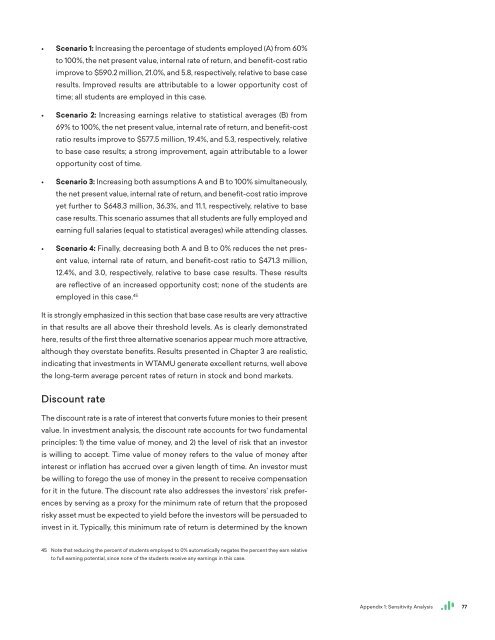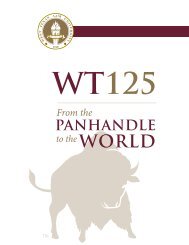The Economic Value of WTAMU Main Report
This report assesses the impact of West Texas A&M University (WTAMU) on the regional economy and the benefits generated by the university for students, taxpayers, and society. The results of this study show that WTAMU creates a positive net impact on the regional economy and generates a positive return on investment for students, taxpayers, and society.
This report assesses the impact of West Texas A&M University (WTAMU) on the regional economy and the benefits generated by the university for students, taxpayers, and society. The results of this study show that WTAMU creates a positive net impact on the regional economy and generates a positive return on investment for students, taxpayers, and society.
Create successful ePaper yourself
Turn your PDF publications into a flip-book with our unique Google optimized e-Paper software.
• Scenario 1: Increasing the percentage <strong>of</strong> students employed (A) from 60%<br />
to 100%, the net present value, internal rate <strong>of</strong> return, and benefit-cost ratio<br />
improve to $590.2 million, 21.0%, and 5.8, respectively, relative to base case<br />
results. Improved results are attributable to a lower opportunity cost <strong>of</strong><br />
time; all students are employed in this case.<br />
• Scenario 2: Increasing earnings relative to statistical averages (B) from<br />
69% to 100%, the net present value, internal rate <strong>of</strong> return, and benefit-cost<br />
ratio results improve to $577.5 million, 19.4%, and 5.3, respectively, relative<br />
to base case results; a strong improvement, again attributable to a lower<br />
opportunity cost <strong>of</strong> time.<br />
• Scenario 3: Increasing both assumptions A and B to 100% simultaneously,<br />
the net present value, internal rate <strong>of</strong> return, and benefit-cost ratio improve<br />
yet further to $648.3 million, 36.3%, and 11.1, respectively, relative to base<br />
case results. This scenario assumes that all students are fully employed and<br />
earning full salaries (equal to statistical averages) while attending classes.<br />
• Scenario 4: Finally, decreasing both A and B to 0% reduces the net present<br />
value, internal rate <strong>of</strong> return, and benefit-cost ratio to $471.3 million,<br />
12.4%, and 3.0, respectively, relative to base case results. <strong>The</strong>se results<br />
are reflective <strong>of</strong> an increased opportunity cost; none <strong>of</strong> the students are<br />
employed in this case. 45<br />
It is strongly emphasized in this section that base case results are very attractive<br />
in that results are all above their threshold levels. As is clearly demonstrated<br />
here, results <strong>of</strong> the first three alternative scenarios appear much more attractive,<br />
although they overstate benefits. Results presented in Chapter 3 are realistic,<br />
indicating that investments in <strong>WTAMU</strong> generate excellent returns, well above<br />
the long-term average percent rates <strong>of</strong> return in stock and bond markets.<br />
Discount rate<br />
<strong>The</strong> discount rate is a rate <strong>of</strong> interest that converts future monies to their present<br />
value. In investment analysis, the discount rate accounts for two fundamental<br />
principles: 1) the time value <strong>of</strong> money, and 2) the level <strong>of</strong> risk that an investor<br />
is willing to accept. Time value <strong>of</strong> money refers to the value <strong>of</strong> money after<br />
interest or inflation has accrued over a given length <strong>of</strong> time. An investor must<br />
be willing to forego the use <strong>of</strong> money in the present to receive compensation<br />
for it in the future. <strong>The</strong> discount rate also addresses the investors’ risk preferences<br />
by serving as a proxy for the minimum rate <strong>of</strong> return that the proposed<br />
risky asset must be expected to yield before the investors will be persuaded to<br />
invest in it. Typically, this minimum rate <strong>of</strong> return is determined by the known<br />
45 Note that reducing the percent <strong>of</strong> students employed to 0% automatically negates the percent they earn relative<br />
to full earning potential, since none <strong>of</strong> the students receive any earnings in this case.<br />
Appendix 1: Sensitivity Analysis<br />
77





